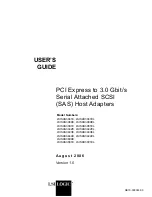
sasmgr [-h] set_attr -D device_file -q lun=lun_dsf -q locate_led={on |
off}
sasmgr [-h][-f] set_attr -D device_file -q raid -q raid_vol=rvol_id -q
state=vol_state
sasmgr [-h][-f] set_attr -D device_file -q raid -q raid_vol=rvol_id -q
rebuild_rate=rebuild_rate
A
-N
option has been added to the
sasmgr
utility for HP-UX 11i v3. For example:
sasmgr -N get_info -D /dev/sasd0 -q raid
When this option is specified for some commands, it enables you to specify the persistent device
file as input to a qualifier. For some commands, when this option is specified, the output will
display persistent device file information.
If the
-N
option is not specified,
sasmgr
will accept and display only legacy device file
information. This provides backward compatibility with previous versions of HP-UX. For more
information on persistent device files in HP-UX 11i v3, see the
intro(7)
manpage.
The sasmgr Command Set
A command is defined by a set of qualifiers. Attributes are specified with the -q option. All
keywords are case-sensitive. The following commands are recognized by
sasmgr
.
add
One of the following sets of qualifiers must be specified with the add command:
•
raid
•
level
•
enc_bay
•
size
•
rebuild_rate
Use this set of qualifiers to create a RAID volume with the specified RAID
level, volume size and physical disks. The value specified for the
level
qualifier determines the RAID level for the volume. For example,
-q level=1
specifies that a RAID 1 volume should be created. If the physical disks in a
RAID volume are different sizes, then some disk space will be wasted. Volume
expansion is not supported; once a volume has been created, its size cannot
be increased. If the
size
qualifier is not specified, then the volume is created
with a maximum possible size based on the size of the physical disks specified.
If the
rebuild_rate
qualifier is not specified, then the default rebuild rate
of 20% will be used for the volume. If the
-f
option is not specified,
sasmgr
displays a warning message before continuing the command. Otherwise, it
suppresses the warning and executes the command. This command requires
superuser privileges. See
“Security Restrictions” (page 68)
.
•
raid
•
spare
•
enc_bay
Use this set of qualifiers to add a global spare disk. The global spare disk is
used whenever a physical disk in any RAID volume on the controller fails.
The size of the disk specified should be greater than the size of at least one of
the physical disks in the volume. If the
-f
option is not specified,
sasmgr
displays a warning message before continuing the command. Otherwise, it
suppresses the warning message and continues executing the command. This
command requires superuser privileges. See
“Security Restrictions” (page 68)
.
54
Configuring and Troubleshooting the Controller Online
















































